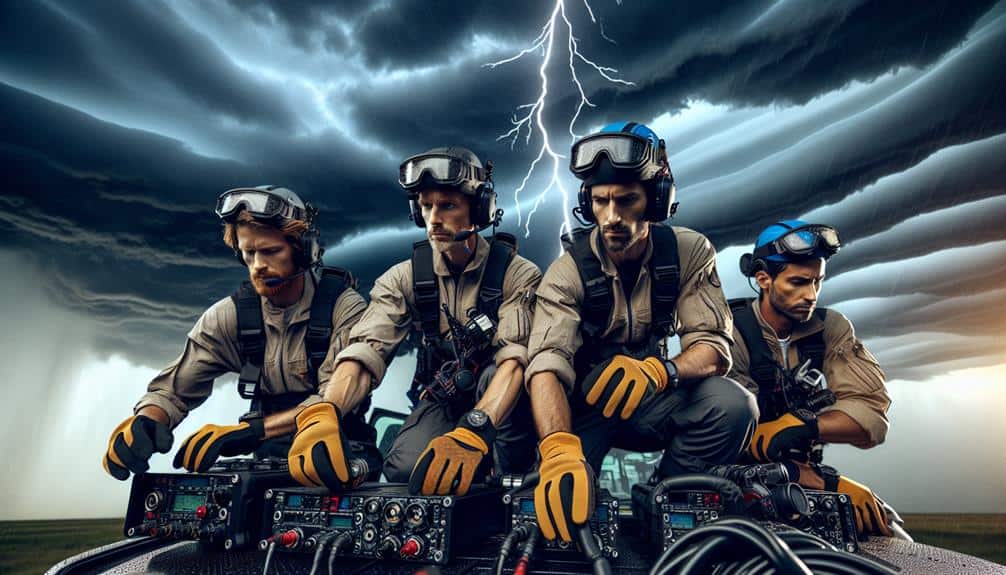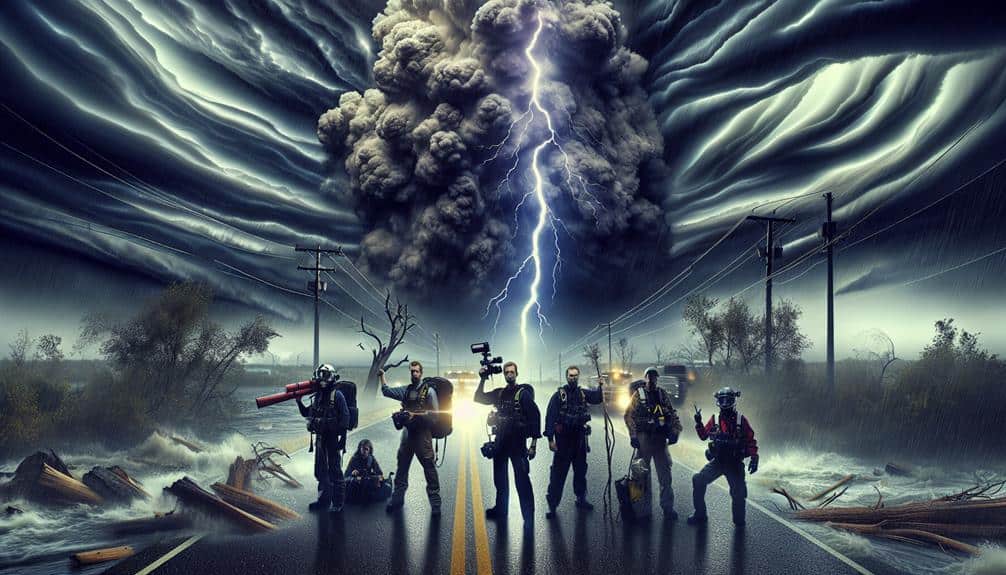As storm patterns intensify due to climate change, we must improve predictive models with machine learning, adopt strict safety protocols, and prepare strong emergency kits. Enhanced data collection through drones and mobile weather stations is vital for real-time updates. Equipping vehicles with survival essentials and communication devices guarantees operational efficiency and safety. Collaborating with environmental scientists and integrating ethical considerations in our practices helps reduce impacts on communities. By adopting these measures, storm chasers can effectively navigate the challenges posed by evolving weather phenomena and strengthen their preparedness strategies to face future storms. Discover the essential strategies and technologies driving this preparedness.
Key Points
- Equip storm chasers with advanced weather tracking technology and real-time communication tools for accurate data collection and safety.
- Implement rigorous safety protocols and provide essential survival gear to minimize risks during increasingly severe storms.
- Enhance predictive models using machine learning to improve forecasting accuracy and help storm chasers prepare effectively.
- Ensure vehicles are outfitted with comprehensive emergency kits, including medical supplies and communication devices.
Increased Storm Frequency
As climate change accelerates, we're witnessing a significant uptick in the frequency of severe storms, demanding more robust data collection and predictive models. This escalation necessitates enhanced community preparedness and more efficient disaster response mechanisms.
Our first priority must be identifying and mapping out evacuation routes to secure swift, safe exits for residents in storm-prone areas. Equally critical is the establishment and maintenance of well-equipped emergency shelters to provide refuge during extreme weather events.
To bolster our predictive capabilities, we should integrate advanced meteorological tools and real-time data analytics. These technologies will enable us to anticipate storm paths and intensities with higher accuracy, thereby optimizing evacuation plans and resource allocation.
Community preparedness programs, including regular drills and public education initiatives, are essential in fostering a proactive stance toward storm threats. By engaging residents in these activities, we can cultivate a culture of readiness and resilience.
In tandem, disaster response strategies need continuous refinement to address the evolving nature of storms. Coordinated efforts between local authorities, emergency services, and volunteers will secure a swift, organized response to minimize casualties and property damage.
Together, we can navigate the challenges posed by increased storm frequency, safeguarding our communities' freedom and well-being.
Intensified Storm Severity
Facing the reality of intensified storm severity, we must harness cutting-edge meteorological research and advanced engineering solutions to mitigate the profound impacts on our infrastructure and communities. The increasing energy within storm systems leads to higher wind speeds, greater precipitation rates, and more destructive storm surges. These factors contribute significantly to community impact and strain our infrastructure resilience.
By employing state-of-the-art predictive models, we can more accurately forecast storm behavior, allowing for timely disaster preparedness measures. Advanced simulations enable us to design stronger buildings and fortify critical infrastructure against extreme weather conditions. This proactive approach not only saves lives but also reduces the long-term economic burden of storm damage.
Evacuation routes must be meticulously planned and regularly updated, taking into account the heightened threat levels. Geographic Information Systems (GIS) can be utilized to identify optimal evacuation pathways and safe zones, ensuring efficient and effective community evacuation during emergencies.
Moreover, public education campaigns are crucial. Communities need to understand the importance of readiness and the steps they can take to protect themselves. By integrating these strategies, we can enhance our resilience against the escalating severity of storms, safeguarding our freedoms and livelihoods.
Altered Storm Patterns
Our understanding of altered storm patterns hinges on analyzing extensive climate data that reveals significant shifts in storm frequency, duration, and trajectories. We observe that storms aren't only becoming more frequent but also exhibiting prolonged durations and altered paths, directly impacting our approach to storm chasing.
These shifts are closely tied to changing landscapes. As climate change remodels our environment, it affects atmospheric conditions, sea surface temperatures, and wind patterns. For instance, warmer oceans fuel more intense and longer-lasting storms. Additionally, shifting wind patterns can redirect storm trajectories, bringing severe weather to regions previously considered low-risk.
To adapt, we need to adopt evolving strategies. Traditional storm chasing methods may not suffice in this new climate reality. Our strategies must now incorporate real-time data analysis and adaptive planning.
Advancements in Storm Prediction
Leveraging advancements in storm prediction technology, we can now more accurately forecast storm behaviors and mitigate risks associated with extreme weather events. Technology integration has revolutionized our approach to storm tracking, allowing us to harness data from satellites, Doppler radar, and ground-based sensors. By combining these data streams, we achieve unprecedented forecast accuracy, providing critical lead times for communities in the storm's path.
Our use of sophisticated data analysis tools enables us to discern patterns and trends that were previously undetectable. Machine learning algorithms, for instance, analyze vast datasets in real-time, refining our predictive models with each storm cycle. This continuous improvement loop enhances our ability to anticipate the intensity, trajectory, and potential impact of severe weather events.
Additionally, advanced storm tracking systems grant us the freedom to adapt our strategies on-the-fly. Mobile weather stations and drones equipped with high-resolution cameras and sensors provide dynamic, real-time updates. These innovations guarantee that we not only react to storms but proactively prepare for them, minimizing damage and safeguarding lives.
Safety Protocols and Equipment

As storm chasers, we prioritize safety by adhering to strict protocols and using advanced equipment. Our essential gear checklist includes GPS devices, protective clothing, and first aid kits. Our emergency response plans guarantee rapid action during critical situations.
Real-time communication tools, such as satellite phones and mobile apps, enable immediate updates and coordination, improving overall safety and efficiency.
Essential Gear Checklist
To effectively navigate the unpredictable conditions brought on by climate change, storm chasers must equip themselves with a thorough gear checklist that prioritizes both safety protocols and essential equipment. Our approach should be data-driven and precise, ensuring we're prepared for any scenario.
We need to focus on survival essentials and advanced weather tracking tools integrated with the latest technology for accurate risk assessments.
Here's our essential gear checklist:
- Survival essentials: This includes items like first-aid kits, emergency food supplies, water purification tablets, and thermal blankets. These are vital for staying safe during prolonged exposure to severe weather.
- Weather tracking equipment: High-quality anemometers, barometers, and portable weather stations are indispensable. These tools provide real-time data on storm conditions, helping us make informed decisions quickly.
- Technology integration: Utilizing GPS devices, satellite phones, and drone technology can greatly enhance our ability to track storms and communicate in real-time. These gadgets are paramount for both data collection and safety.
Emergency Response Plans
Building on our gear checklist, we must establish detailed emergency response plans that cover precise safety protocols and the necessary equipment to ensure our team's resilience during extreme weather events. First, we need to identify and map out evacuation routes and shelter locations in every operational area. These routes should be regularly updated based on current topographical and infrastructural data to guarantee safety.
Furthermore, we must prioritize first aid training and survival skills for all team members. Thorough first aid training will enable us to handle injuries effectively, from minor cuts to more severe traumas. Survival skills, such as finding drinkable water and constructing temporary shelters, are crucial for situations where we may be stranded for extended periods.
Outfitting our vehicles with emergency kits that include medical supplies, water purification tools, and non-perishable food is necessary. Additionally, we should carry personal protective equipment (PPE) like helmets, gloves, and sturdy boots to reduce injury risks during field operations.
Real-Time Communication Tools
Effective real-time communication tools are vital for ensuring the safety and coordination of our storm-chasing team during extreme weather events. The integration of advanced technology allows us to maintain constant connectivity and situational awareness.
Remote monitoring systems, combined with robust data integration techniques, enable us to make informed decisions quickly.
To enhance our operational efficiency and safety protocols, we utilize several key tools:
- Satellite Communications: Provide uninterrupted data transmission, ensuring we remain connected in areas with limited cellular coverage.
- Mobile Weather Stations: Collect and relay meteorological data in real-time, enhancing our understanding of storm dynamics.
- GPS Tracking Devices: Allow precise location monitoring of all team members, essential for coordinated movements.
Environmental and Ethical Considerations
As storm chasers, we must thoroughly evaluate the environmental impact of our activities and address the ethical implications of our interactions with communities affected by severe weather events. Ethical dilemmas arise when our pursuit of data and experiences potentially disrupts ecosystems or imposes on local populations already stressed by severe weather. It's crucial that we adopt responsible practices, such as minimizing vehicle emissions and adhering to designated paths to reduce environmental degradation.
Our conservation efforts should extend beyond our immediate activities. For instance, we can collaborate with environmental scientists to monitor and mitigate the broader environmental impact of our presence in storm-affected regions. Data-driven approaches help us quantify our footprint and implement corrective measures effectively.
Furthermore, ethical considerations demand that we prioritize the well-being of affected communities. Engaging with local authorities and relief organizations guarantees our presence supports rather than hinders recovery efforts. Transparency in our objectives and methods fosters trust and cooperation, essential for ethical storm chasing.
Frequently Asked Questions
How Does Climate Change Impact the Duration of Storm-Chasing Seasons?
A stitch in time saves nine. Climate change causes seasonal shifts, lengthening storm-chasing seasons. We must harness technology advancements, enhance safety protocols, and optimize data collection to adapt. Freedom relies on our ability to stay ahead.
What Training Do Storm Chasers Need to Adapt to Climate Change?
We need to enhance our field techniques and climate adaptation strategies. Advanced technology and precise data collection methods are essential. Training must focus on real-time analysis and rapid response to changing storm patterns due to climate change.
How Do Changing Storm Patterns Affect Local Communities' Emergency Preparedness?
We need to secure the hatches as changing storm patterns complicate emergency response. Community resilience hinges on data-driven strategies, timely communications, and adaptive infrastructure to safeguard our freedoms and guarantee swift, effective disaster management.
What Role Do Storm Chasers Play in Collecting Climate Change Data?
We play a significant role in data collection by tracking storm patterns and collaborating with research institutions. Our precise data aids in understanding climate change impacts, empowering communities to adapt and maintain freedom amidst evolving environmental challenges.
How Can Storm Chasers Collaborate With Meteorologists to Improve Climate Change Models?
We can enhance climate change models by engaging in collaborative research with meteorologists, focusing on data collection. By integrating our technology with theirs, we'll boost forecast accuracy, providing more precise, actionable information for those seeking freedom from uncertainty.


